Madmaheshwar Temple: Dedicated to Lord Shiva’s Belly Button
Madmaheshwar Temple (मध्यमहेश्वर) is a Hindu temple dedicated to Lord Shiva, located in Gaundar, a village in the Garhwal Himalayas of Uttarakhand, India. Situated at an elevation of 3,497 m (11,473.1 ft), it is one of the Panch Kedar pilgrimage circuits, comprising five Shiva temples in the Garhwal region. The other temples in the circuit include: Kedarnath, Tungnath and Rudranath which are culturally visited before Madhyamaheshwar and, Kalpeshwar generally visited after Madhyamaheshwar. The middle (madhya) or belly part or navel (nabhi) of Shiva is worshipped here.
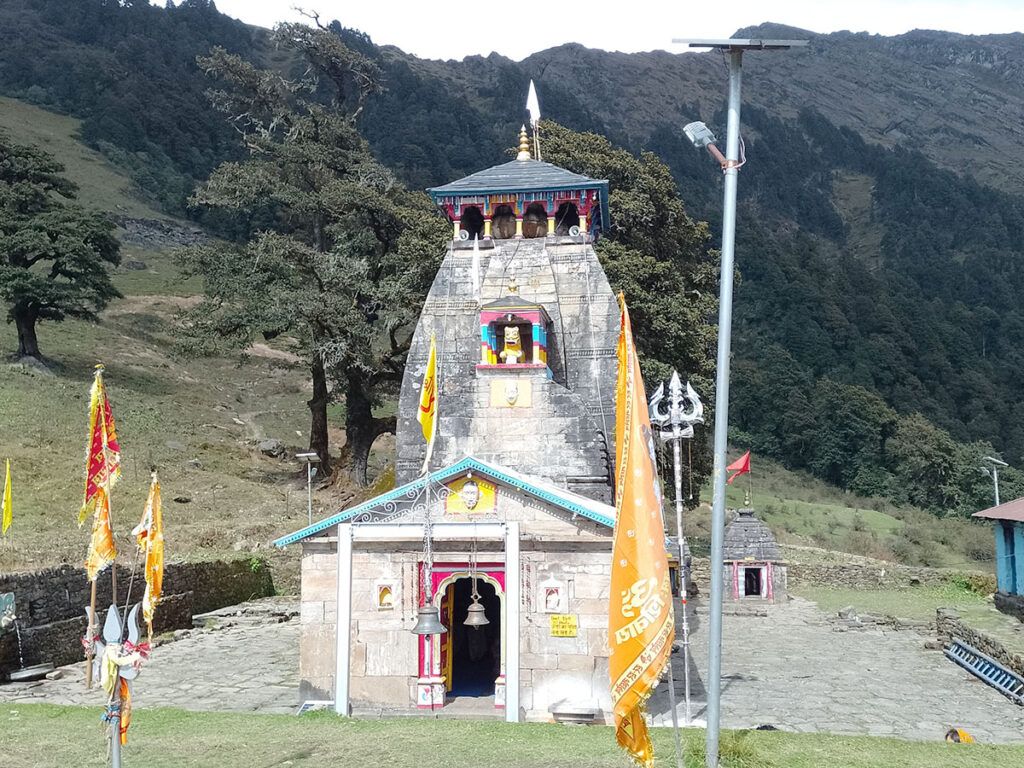
Contents
- 1 Madmaheshwar Temple History:
- 2 Legend of Madmaheshwar Temple:
- 3 Significance of Madmaheshwar Temple:
- 4 Myths of Madmaheshwar Temple:
- 5 Architecture of Madmaheshwar Temple:
- 6 Madmaheshwar Temple Timing:
- 7 Places to visit near Madmaheshwar Temple:
- 8 FAQ:
- 8.0.1 Q: When is the best time to visit the Madmaheshwar Temple?
- 8.0.2 Q: How do I get to the Madmaheshwar Temple?
- 8.0.3 Q: Is the trek to the Madmaheshwar Temple difficult?
- 8.0.4 Q: What do I need to bring on the trek to the Madmaheshwar Temple?
- 8.0.5 Q: Where can I stay near the Madmaheshwar Temple?
- 8.0.6 Q: What are the opening and closing times of the Madmaheshwar Temple?
- 8.0.7 Q: Are there any restrictions on what I can wear to the Madmaheshwar Temple?
- 9 How to reach Madmaheshwar Temple?
- 10 Google Maps:
Madmaheshwar Temple History:
The history of the Madmaheshwar Temple is closely associated with the Hindu epic Mahabharata. According to legend, after the war of Kurukshetra, the Pandavas were filled with guilt and remorse for killing their own kin. They sought the forgiveness of Lord Shiva in order to attain salvation.
Lord Shiva, however, was angry with the Pandavas for their role in the war. He disguised himself as a bull and hid in the Garhwal Himalayas. The Pandavas pursued Shiva and eventually found him grazing in a meadow.
Bhima, the second Pandava brother, tried to catch Shiva by the tail. However, Shiva disappeared and reappeared in five different places, each of which represented a different part of his body:
- Kedarnath: Hump
- Tungnath: Arms
- Madmaheshwar: Stomach and navel
- Rudranath: Face
- Kalpeshwar: Head and hair
The Pandavas built temples at each of these five places to worship Lord Shiva. The Madmaheshwar Temple is therefore one of the five Panch Kedar temples, which are considered to be among the most sacred Shiva temples in India.
The Madmaheshwar Temple is located in the Garhwal Himalayas at an altitude of 3,497 meters. The temple is dedicated to Lord Shiva in the form of a navel-shaped lingam. The temple is surrounded by lush meadows and snow-capped mountains, making it a truly breathtaking sight.
Read More>> 2500 Years Dwarkadhish Temple: Where Miracles Still Happen
Legend of Madmaheshwar Temple:
The legend of Madmaheshwar Temple is closely associated with the Hindu epic Mahabharata. After the Kurukshetra War, the Pandavas were remorseful for the sins they had committed, including fratricide and the killing of Brahmins. They sought the forgiveness of Lord Shiva, but he was so angry with them that he refused to meet them.
The Pandavas did not give up their quest to find Shiva. They traveled all over India, seeking his blessings. Finally, they arrived in the Garhwal Himalayas, where they found Shiva in the form of a bull.
Bhima, the strongest Pandava, recognized Shiva and tried to catch him. However, Shiva was too powerful for Bhima. He disappeared into the ground and reappeared in five different places. His hump appeared at Kedarnath, his arms at Tungnath, his face at Rudranath, his navel at Madmaheshwar, and his hair at Kalpeshwar.
The Pandavas built temples at each of these five places to worship Lord Shiva. These temples are known as the Panch Kedars, and they are some of the most sacred pilgrimage sites in Hinduism.
The Madmaheshwar Temple is located at an altitude of 3,497 meters above sea level. It is a challenging trek to reach the temple, but the views from the top are breathtaking. The temple is also known for its unique Navel-shaped Shiva lingam.
Read More>> Raghavendra Swamy Temple Mantralayam
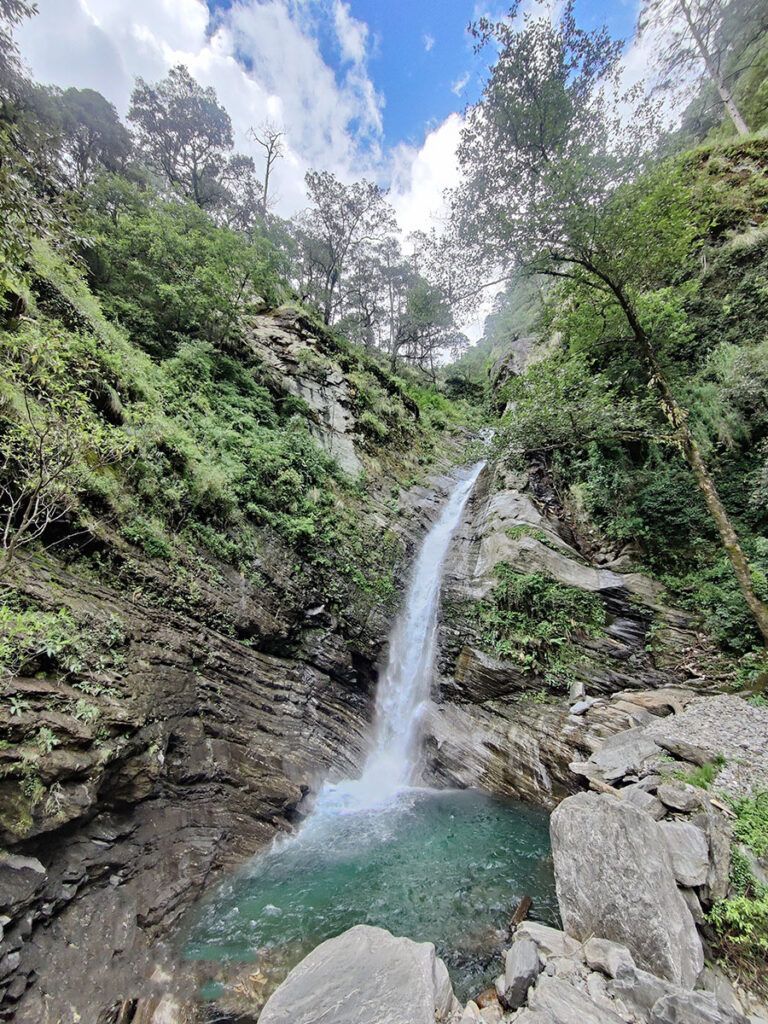
Significance of Madmaheshwar Temple:
The significance of Madmaheshwar Temple is due to its religious importance, its cultural significance, and its natural beauty.
Religious importance:
- Madmaheshwar Temple is one of the five Panch Kedar temples, which are dedicated to Lord Shiva in the Garhwal Himalayas.
- The temple is worshipped in the form of a navel-shaped Lingam, which is a rare and unique form of Shiva.
- According to Hindu mythology, the Pandavas, the five heroes of the Mahabharata, built the Madmaheshwar Temple to atone for their sins.
Cultural significance:
- The Madmaheshwar Temple is a major pilgrimage site for Hindus from all over India.
- The temple is also a popular tourist destination, attracting visitors from all over the world.
- The temple is a symbol of Hindu culture and heritage.
Natural beauty:
- The Madmaheshwar Temple is located in a scenic setting, surrounded by snow-capped mountains and lush green forests.
- The temple offers stunning views of the surrounding Himalayas.
- The natural beauty of the area enhances the religious and cultural significance of the temple.
Read More>> Shri Kalabhairaveshwara Temple Bengaluru
Myths of Madmaheshwar Temple:
The Madmaheshwar Temple is one of the five Panch Kedar temples dedicated to Lord Shiva. It is located in the Garhwal Himalayas of Uttarakhand, India. The temple is situated at an altitude of 3490 meters above sea level.
There are many myths and legends associated with the Madmaheshwar Temple. One of the most popular myths is the story of the Pandavas. After the Mahabharata war, the Pandavas were seeking forgiveness from Lord Shiva for their sins. They traveled to the Himalayas in search of Shiva, but he disguised himself as a bull and disappeared into the ground. The Pandavas followed the bull, and it tore itself into five parts, which appeared at five different locations. The navel of the bull appeared at Madmaheshwar, and this is where the temple is located.
Another myth associated with the Madmaheshwar Temple is that it is the place where Lord Shiva and Parvati got married. It is also said that the temple is located on the spot where Lord Shiva performed the Tandava dance.
The Madmaheshwar Temple is a popular pilgrimage site, and thousands of devotees visit the temple every year. The temple is also a popular trekking destination, and many people trek to the temple from nearby villages.
Read More>> Gangotri Temple | Complete Guide
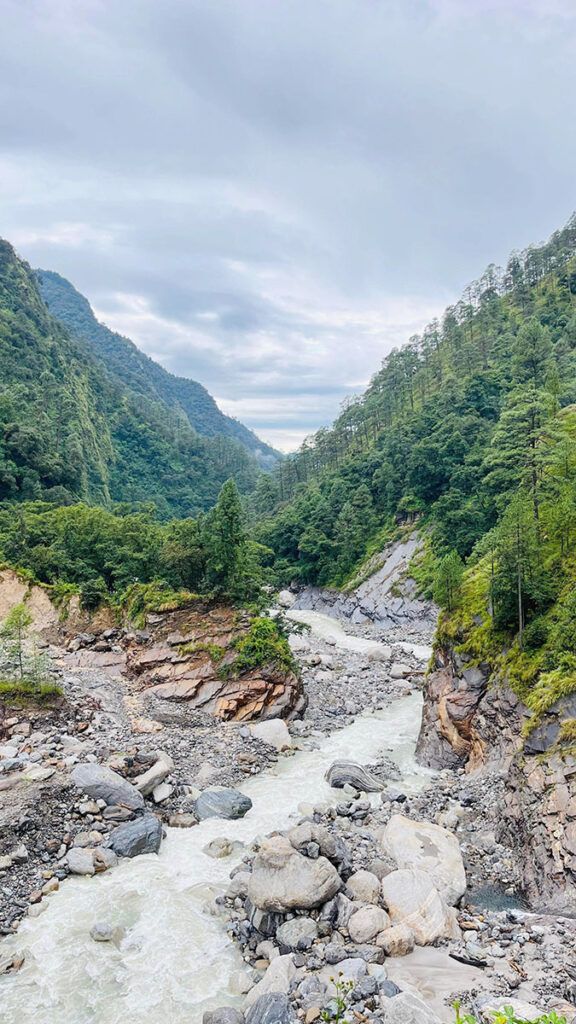
Architecture of Madmaheshwar Temple:
The temple is built in the North-Indian Himalayan style of architecture. It is a simple, stone structure with a shikhara (tower) that rises above the sanctum. The sanctum contains a black stone lingam (aniconic representation of Shiva).
The temple complex also includes two other smaller shrines, one for Shiva’s consort Parvati and the other dedicated to Ardhanarishwara, a half-Shiva half-Parvati image.
The Madhyamaheshwar Temple is a popular pilgrimage site for Hindus. It is believed that the temple was built by the Pandava brothers, Bhima and Arjuna, during the Mahabharata period. The temple is also associated with the sage Vyasa, who is said to have composed the Mahabharata at this place.
Key features of the Madhyamaheshwar Temple architecture:
- Simple, stone structure
- Shikhara (tower) that rises above the sanctum
- Black stone lingam in the sanctum
- Two other smaller shrines for Parvati and Ardhanarishwara
- Located in a lush meadow, just below a high ridge
Read More>> Shri Jogadya Shaktipeeth, Kshirgram, West Bengal
Madmaheshwar Temple Timing:
Madmaheshwar Temple is open from 6:00 AM to 9:00 PM. However, the temple is closed from November to April due to heavy snowfall.
Here are the timings of the aarti ceremonies at the temple:
- Morning aarti: 6:00 AM to 6:30 AM
- Evening aarti: 6:00 PM to 6:30 PM
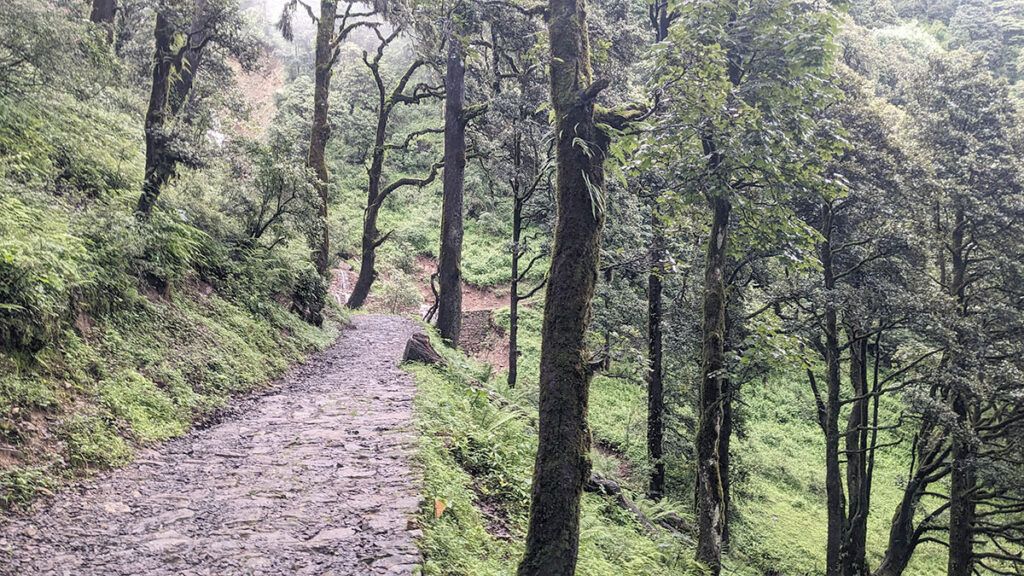
Places to visit near Madmaheshwar Temple:
Kedarnath Temple: Kedarnath is one of the holiest shrines in Hinduism and is also part of the Panch Kedar circuit. It’s about 16 kilometers from Madmaheshwar and can be reached by trekking or other modes of transportation.
Tungnath Temple: Tungnath, the highest Shiva temple in the world, is another significant pilgrimage site in the region. It’s around 40 kilometers from Madmaheshwar and is known for its scenic beauty.
Chopta: Often referred to as the “Mini Switzerland of India,” Chopta is a beautiful hill station and a base for the trek to Tungnath. The lush green meadows and stunning views of the Himalayas make it a popular destination for nature lovers.
Guptkashi: This town is known for its ancient Vishwanath Temple dedicated to Lord Shiva. It’s a significant pilgrimage site and a starting point for the trek to Kedarnath.
Rudraprayag: Situated at the confluence of the Alaknanda and Mandakini rivers, Rudraprayag is a town with religious significance. The scenic beauty and the sacred confluence make it a peaceful place to visit.
Kalimath: About 41 kilometers from Madmaheshwar, Kalimath is known for the Goddess Kali Temple. The trek to Kalimath is scenic, and the temple is revered by locals.
Deoria Tal: A pristine lake surrounded by lush greenery and snow-capped peaks, Deoria Tal offers breathtaking views of Chaukhamba peaks. It’s a trekking destination located around 60 kilometers from Madmaheshwar.
Gaurikund: Gaurikund is a significant pilgrimage site and the starting point for the trek to Kedarnath. It’s named after Goddess Parvati (Gauri), and there is a hot water spring believed to be the spot where she performed penance.
Read More>> Kankalitala Shakti Peeth Temple
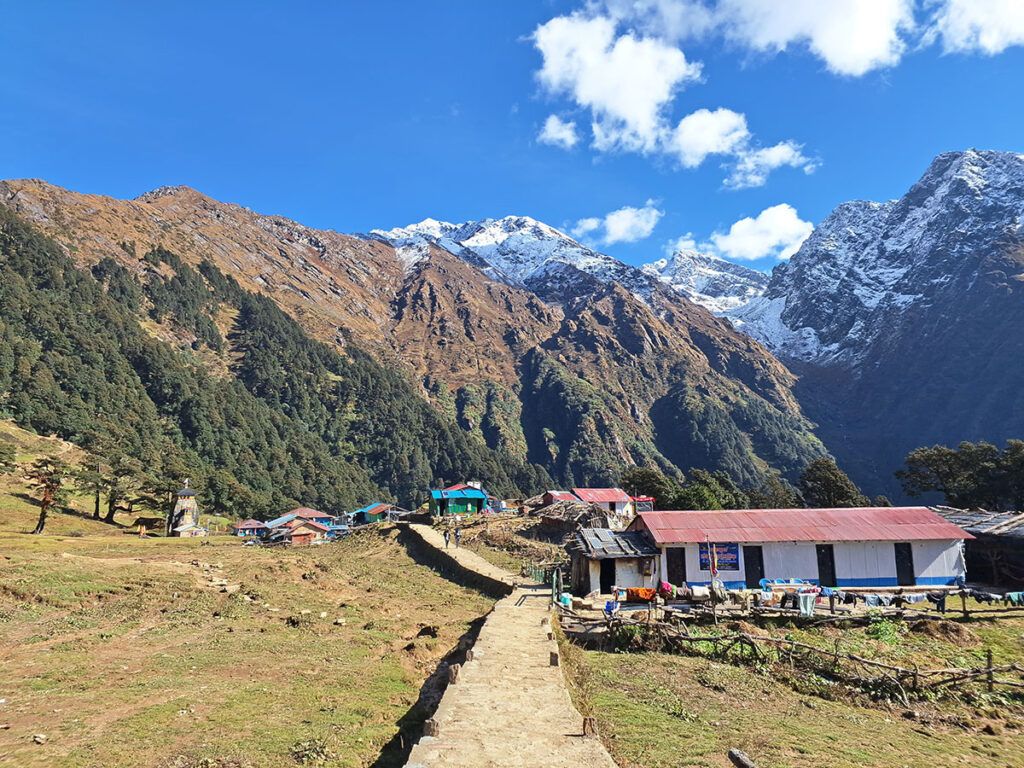
FAQ:
Q: When is the best time to visit the Madmaheshwar Temple?
A: The best time to visit the Madmaheshwar Temple is from May to October, when the weather is pleasant and the temple is open to pilgrims. The temple is closed from November to April due to heavy snowfall.
Q: How do I get to the Madmaheshwar Temple?
A: The nearest airport to the Madmaheshwar Temple is Jolly Grant Airport in Dehradun, which is about 205 km away. The nearest railway station is Haridwar Railway Station, which is about 225 km away. From either airport or railway station, you can take a taxi or bus to Ukhimath, which is the base camp for the trek to the Madmaheshwar Temple. The trek from Ukhimath to the temple is about 16 km long and takes about 7-8 hours to complete.
Q: Is the trek to the Madmaheshwar Temple difficult?
A: The trek to the Madmaheshwar Temple is considered to be moderate in difficulty. The trail is well-marked and there are many places to stop and rest along the way. However, the trek is long and there is some elevation gain, so it is important to be in good physical condition before attempting it.
Q: What do I need to bring on the trek to the Madmaheshwar Temple?
A: You should bring the following items on the trek to the Madmaheshwar Temple:
- Comfortable hiking shoes or boots
- Backpack with enough food and water for the day
- Rain gear
- Sunscreen and hat
- Warm clothes for the evening
- First-aid kit
- Camera (optional)
Q: Where can I stay near the Madmaheshwar Temple?
A: There are a few guesthouses and hotels located near the Madmaheshwar Temple. However, it is advisable to book your accommodation in advance, especially during the peak season.
Q: What are the opening and closing times of the Madmaheshwar Temple?
A: The Madmaheshwar Temple is open from 6 AM to 9 PM.
Q: Are there any restrictions on what I can wear to the Madmaheshwar Temple?
A: Yes, there are some restrictions on what you can wear to the Madmaheshwar Temple. Men are required to wear a dhoti or kurta, and women are required to wear a sari or salwar kameez. You should also remove your shoes before entering the temple.
For More details visit Uttarakhand Official Tourism Website.
How to reach Madmaheshwar Temple?
1. Reach Rishikesh or Haridwar:
- Start your journey by reaching the towns of Rishikesh or Haridwar, which are well-connected by road and rail.
2. Travel to Ukhimath:
- From Rishikesh or Haridwar, take a bus or hire a taxi to reach Ukhimath, which is approximately 190 km from Rishikesh.
- Ukhimath serves as a base for several treks in the region.
3. Ukhimath to Ransi:
- From Ukhimath, proceed to Ransi, which is the last motorable point on the route to Madmaheshwar.
- The distance between Ukhimath and Ransi is around 45 km, and it takes about 2-3 hours by road.
4. Trek from Ransi to Madmaheshwar:
- The trekking trail from Ransi to Madmaheshwar is approximately 21 km.
- The trek is moderately challenging and involves walking through picturesque landscapes and dense forests.
- It usually takes about 8-10 hours to complete the trek, depending on your pace and weather conditions.
5. Accommodation:
- There are guesthouses and small accommodations available in Ransi and along the trekking route. It’s advisable to check for availability and make reservations in advance.
6. Guides and Porters:
- If you are not familiar with the trekking route, it’s recommended to hire a local guide who is knowledgeable about the terrain.
- Porters can also be hired to carry heavy backpacks, making the trek more comfortable.
7. Check Weather Conditions:
- Before embarking on the trek, check the weather conditions and ensure that you are well-prepared with appropriate clothing and gear.
8. Permits and Permissions:
- Check if any permits or permissions are required for the trek and make sure to obtain them in advance.
9. Plan According to Season:
- Madmaheshwar Temple is usually open from May to October. Plan your visit during these months when the weather is relatively favorable.
